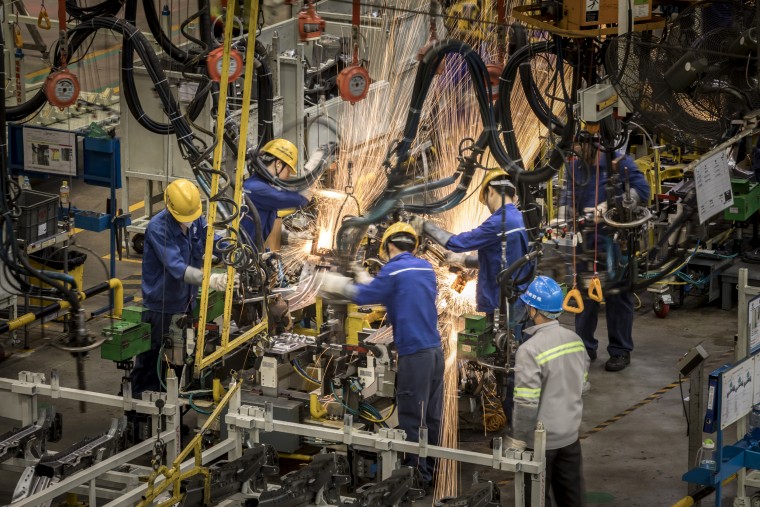As pivotal trade talks between delegations from the United States and China get under way this week, some economists are taking issue with President Donald Trump’s characterization of the impact that his trade sanctions have had on the Chinese economy.
Commerce Department Secretary Wilbur Ross said in an interview on CNBC’s Squawk Box on Monday that the Trump tariffs were causing slower growth and raising the potential of political instability. He said China’s slowdown was a “big problem in their context of having a very big need to create millions of millions of jobs to hold down social unrest.”
However, “I would characterize the Chinese economy as slowing, for sure, but we wouldn’t blame it on the trade issue,” said Paul Christopher, head of global market strategy for the Wells Fargo Investment Institute.
“I think China wants to get it resolved. Their economy’s not doing well," Trump told reporters on Friday.
Trade and market expert say statements such as this lack two things: An acknowledgement that investor anxiety over the potential impact of a drawn-out trade war on the U.S. economy also contributed to market volatility that has sent equities plummeting over the past several weeks, and an understanding of the factors from which China’s economic woes stem.
“Today, both the U.S. and China are negatively affected by the current tensions,” said Ludovic Subran, global economist at Euler Hermes. “The big issue is really more the domestic economy and its transformation,” he said.
“There’s evidence that the latest round of economic reforms started to slow the economy before we got to the tariffs,” Christopher said. In terms of advancing a mix of expansionary and tightening policies, China is still tinkering with the balance. “They haven’t really found the right combination yet,” he said. “We think they’re still experimenting.”
A decrease in Chinese car sales is one key data point that has been misconstrued, China experts say. Automotive consulting firm ZoZoGo found that car sales in China reversed course last year and fell by 3 percent after roughly two decades of growth, and the country’s largest automotive trade group also has reported sinking sales figures in recent months.
Nicholas Lardy, a senior fellow at Peterson Institute for International Economics, said that a temporary tax break spurred Chinese consumers to accelerate car-buying, and the subsequent falloff is a natural outcome of pulling forward demand.
Strong growth in Chinese exports to the U.S. for much of 2018 could indicate an acceleration of commerce as businesses scramble to get goods and manufacturing inputs over the border before any additional tariffs kick in.
“The trade flows alone don’t tell the whole story. Some of the strength of U.S. imports from China is the result of firms trying to ship products before more tariffs are applied, so it won’t last,” said Mark Williams, chief Asia economist at Capital Economics.
As in the U.S., uncertainty over tariffs has weighed on the Chinese equity market as businesses hold off on investments until they know more about what the future holds. “But the trade war is not the main headwind that China’s economy is facing,” Williams said.
That headwind is tighter domestic financial policymaking, experts say. The Chinese government put sharp curbs on non-bank lending, which had fueled considerable growth in consumer spending, real estate investment and local infrastructure projects, but also ratcheted up the risk factor.
“I think the slowdown is primarily a result of the slowdown in credit,” Lardy said. “By the end of last year, credit was growing at the slowest pace in 10 years,” which has crimped spending, investment and weighed on the Chinese stock market.
More recently, Beijing has been walking back some of these tightening policies to promote a more stimulative economic environment: On Friday, China’s equivalent of the Federal Reserve announced that it would cut bank reserve requirements, which would free up more capital for lending, following pledges to cut taxes and increase infrastructure spending to further stimulate its economy.
Economists say a shrinking pool of credit is one contributor to slower Chinese consumer spending, which has been fueled in recent years by taking on debt, and — as in the U.S. — people are unwilling to add to their debt burden in the face of economic uncertainty. “We also notice households have taken on some debt in recent years, and we think some of them might be reaching their limits,” Christopher said. “Households, we think, are feeling a little bit of a pinch,” he said.
Softness in Chinese household spending also is a result of how consumer economic activity is calculated, experts say. As the Chinese economy matures and its middle class grows, people are spending increasingly more on services ranging from healthcare to education to tourism — spending not captured by metrics that only include purchases of goods.
“Service spending by Chinese households, that growth rate is still at an upward trajectory — it’s not only the level that’s rising, but the growth rate that’s rising,” Christopher said.
